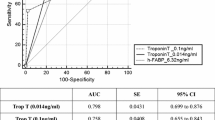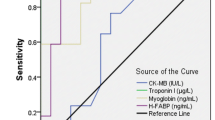Abstract
Chest pain is one of the most common reasons for presentation to the Emergency Department and the ability to rapidly and correctly diagnose the minority of patients who have a myocardial infarction is of critical importance. We assessed the diagnostic performance of a multimarker strategy using heart-type fatty acid binding protein (H-FABP) in combination with a contemporary sensitive troponin (cTn) assay. We measured H-FABP (Randox) and a sensitive cTn (TnI-Ultra, Siemens) at baseline in 343 patients with chest pain enrolled in the prospective BWH-TIMI ED chest pain study. Final presenting diagnosis was adjudicated using all diagnostic data, including the local cTnI results, but reviewers were blinded to H-FABP and the sensitive cTn assays. The diagnostic accuracy of H-FABP and local cTn together (AUC 0.962) was superior to local cTn alone (AUC 0.910, p = 0.0009) with an especially marked improvement in early presenters (AUC 0.983 vs. 0.840, p = 0.0098). In contrast, when combined with the sensitive cTn assay, there was no significant difference in the AUC with H-FABP as compared with the sensitive cTn alone, either in the overall cohort (AUC 0.963 vs. 0.956, p = 0.23) or in early presenters (AUC 0.999 for both). In early presenters, the addition of H-FABP resulted in a NPV of 100 % when combined with either the local or sensitive cTn assay. In our study, the addition of H-FABP significantly enhanced the sensitivity and accuracy of diagnosis as compared to a prior-generation troponin assay alone, especially in patients who presented early. H-FABP but did improve overall diagnostic accuracy when added to a current-generation sensitive troponin assay; however, their combination offered the best NPV in early presenters. Further studies are needed to determine the utility a very rapid “rule out” of MI with a single blood draw of troponin and H-FABP at presentation.
Similar content being viewed by others
References
Nawar EW, Niska RW, Xu J (2007) National hospital ambulatory medical care survey: 2005 emergency department summary. Adv Data 386:1–32
Amsterdam EA, Lewis WR, Yadlapalli S (1999) Evaluation of low-risk patients with chest pain in the emergency department: value and limitations of recent methods. Cardiol Rev 7:17–26
Antman EM, Hand M, Armstrong PW, Bates ER, Green LA, Halasyamani LK, Hochman JS, Krumholz HM, Lamas GA, Mullany CJ, Pearle DL, Sloan MA, Smith SC Jr., 2004 Writing Committee Members, Anbe DT, Kushner FG, Ornato JP, Jacobs AK, Adams CD, Anderson JL, Buller CE, Creager MA, Ettinger SM, Halperin JL, Hunt SA, Lytle BW, Nishimura R, Page RL, Riegel B, Tarkington LG, Yancy CW. (2008) 2007 Focused update of the ACC/AHA 2004 guidelines for the management of patients with st-elevation myocardial infarction: a report of the American college of cardiology/american heart association task force on practice guidelines: developed in collaboration with the canadian cardiovascular society endorsed by the American academy of family physicians: 2007 writing group to review new evidence and update the ACC/AHA 2004 guidelines for the management of patients with ST-elevation myocardial infarction, writing on behalf of the 2004 writing committee. Circulation 117: 296–329
Anderson JL, Adams CD, Antman EM, Bridges CR, Califf RM, E. CD Jr., Chavey WE, 2nd, Fesmire FM, Hochman JS, Levin TN, Lincoff AM, Peterson ED, Theroux P, Wenger NK, Wright RS, C. SS Jr., Jacobs AK, Adams CD, Anderson JL, Antman EM, Halperin JL, Hunt SA, Krumholz HM, Kushner FG, Lytle BW, Nishimura R, Ornato JP, Page RL, Riegel B. (2007) ACC/AHA 2007 guidelines for the management of patients with unstable angina/non-ST-Elevation myocardial infarction: a report of the American college of cardiology/American heart association task force on practice guidelines (writing committee to revise the 2002 guidelines for the management of patients with unstable angina/non-ST-elevation myocardial infarction) developed in collaboration with the American college of emergency physicians, the society for cardiovascular angiography and interventions, and the society of thoracic surgeons endorsed by the American association of cardiovascular and pulmonary rehabilitation and the society for academic emergency medicine. J Am Coll Cardiol 50: e1–e157
Polanczyk CA, Kuntz KM, Sacks DB, Johnson PA, Lee TH (1999) Emergency department triage strategies for acute chest pain using creatine kinase-MB and troponin I assays: a cost-effectiveness analysis. Ann Intern Med 131:909–918
Morrow DA, Antman EM (2009) Evaluation of high-sensitivity assays for cardiac troponin. Clin Chem 55:5–8
Thygesen K, Alpert JS, White HD (2007) Universal definition of myocardial infarction. Eur Heart J 28:2525–2538
Jaffe AS, Babuin L, Apple FS (2006) Biomarkers in acute cardiac disease: the present and the future. J Am Coll Cardiol 48:1–11
Apple FS, Jesse RL, Newby LK, Wu AH, Christenson RH, Cannon CP, Francis G, Morrow DA, Ravkilde J, Storrow AB, Tang W, Jaffe AS, Mair J, Ordonez-Llanos J, Pagani F, Panteghini M, Tate J (2007) National academy of clinical biochemistry and IFCC committee for standardization of markers of cardiac damage laboratory medicine practice guidelines: analytical issues for biochemical markers of acute coronary syndromes. Clin Chem 53:547–551
Keller T, Zeller T, Peetz D, Tzikas S, Roth A, Czyz E, Bickel C, Baldus S, Warnholtz A, Frohlich M, Sinning CR, Eleftheriadis MS, Wild PS, Schnabel RB, Lubos E, Jachmann N, Genth-Zotz S, Post F, Nicaud V, Tiret L, Lackner KJ, Munzel TF, Blankenberg S (2009) Sensitive troponin I assay in early diagnosis of acute myocardial infarction. N Engl J Med 361:868–877
Reichlin T, Hochholzer W, Bassetti S, Steuer S, Stelzig C, Hartwiger S, Biedert S, Schaub N, Buerge C, Potocki M, Noveanu M, Breidthardt T, Twerenbold R, Winkler K, Bingisser R, Mueller C (2009) Early diagnosis of myocardial infarction with sensitive cardiac troponin assays. N Engl J Med 361:858–867
Glatz JF, van Bilsen M, Paulussen RJ, Veerkamp JH, van der Vusse GJ, Reneman RS (1988) Release of fatty acid-binding protein from isolated rat heart subjected to ischemia and reperfusion or to the calcium paradox. Biochim Biophys Acta 961:148–152
Kleine AH, Glatz JF, Van Nieuwenhoven FA, Van der Vusse GJ (1992) Release of heart fatty acid-binding protein into plasma after acute myocardial infarction in man. Mol Cell Biochem 116:155–162
Melanson SE, Morrow DA, Jarolim P (2007) Earlier detection of myocardial injury in a preliminary evaluation using a new troponin I assay with improved sensitivity. Am J Clin Pathol 128:282–286
DeLong ER, DeLong DM, Clarke-Pearson DL (1988) Comparing the areas under two or more correlated receiver operating characteristic curves: a nonparametric approach. Biometrics 44:837–845
O’Donoghue M, de Lemos JA, Morrow DA, Murphy SA, Buros JL, Cannon CP, Sabatine MS (2006) Prognostic utility of heart-type fatty acid binding protein in patients with acute coronary syndromes. Circulation 114:550–557
Ishii J, Wang JH, Naruse H, Taga S, Kinoshita M, Kurokawa H, Iwase M, Kondo T, Nomura M, Nagamura Y, Watanabe Y, Hishida H, Tanaka T, Kawamura K (1997) Serum concentrations of myoglobin vs human heart-type cytoplasmic fatty acid-binding protein in early detection of acute myocardial infarction. Clin Chem 43:1372–1378
Okamoto F, Sohmiya K, Ohkaru Y, Kawamura K, Asayama K, Kimura H, Nishimura S, Ishii H, Sunahara N, Tanaka T (2000) Human heart-type cytoplasmic fatty acid-binding protein (H-FABP) for the diagnosis of acute myocardial infarction. Clinical evaluation of H-FABP in comparison with myoglobin and creatine kinase isoenzyme MB. Clin Chem Lab Med 38:231–238
Seino Y, Ogata K, Takano T, Ishii J, Hishida H, Morita H, Takeshita H, Takagi Y, Sugiyama H, Tanaka T, Kitaura Y (2003) Use of a whole blood rapid panel test for heart-type fatty acid-binding protein in patients with acute chest pain: comparison with rapid troponin T and myoglobin tests. Am J Med 115:185–190
McMahon CG, Lamont JV, Curtin E, McConnell RI, Crockard M, Kurth MJ, Crean P, Fitzgerald SP (2012) Diagnostic accuracy of heart-type fatty acid-binding protein for the early diagnosis of acute myocardial infarction. Am J Emerg Med 30:267–274
McCann CJ, Glover BM, Menown IB, Moore MJ, McEneny J, Owens CG, Smith B, Sharpe PC, Young IS, Adgey JA (2008) Novel biomarkers in early diagnosis of acute myocardial infarction compared with cardiac troponin T. Eur Heart J 29:2843–2850
Haltern G, Peiniger S, Bufe A, Reiss G, Gulker H, Scheffold T (2010) Comparison of usefulness of heart-type fatty acid binding protein versus cardiac troponin T for diagnosis of acute myocardial infarction. Am J Cardiol 105:1–9
Kagawa Y, Toyofuku M, Masaoka Y, Muraoka Y, Okimoto T, Otsuka M, Tamekiyo H, Mito S, Kawase T, Yamane K, Senoo A, Amioka M, Shiode N, Hayashi Y (2011) Comparison of heart-type fatty acid binding protein and sensitive troponin for the diagnosis of early acute myocardial infarction. Int J Cardiol (in print)
Lindsell CJ, Anantharaman V, Diercks D, Han JH, Hoekstra JW, Hollander JE, Kirk JD, Lim SH, Peacock WF, Tiffany B, Wilke EK, Gibler WB, Pollack CV Jr. (2006) EMCREG-international i*trACS investigators. The internet tracking registry of acute coronary syndromes (i*trACS): a multicenter registry of patients with suspicion of acute coronary syndromes reported using the standardized reporting guidelines for emergency department chest pain studies. Ann Emerg Med 48: 666–77, 677. e1–9
Lee TH, Goldman L (2000) Evaluation of the patient with acute chest pain. N Engl J Med 342:1187–1195
Pope JH, Aufderheide TP, Ruthazer R, Woolard RH, Feldman JA, Beshansky JR, Griffith JL, Selker HP (2000) Missed diagnoses of acute cardiac ischemia in the emergency department. N Engl J Med 342:1163–1170
Reichlin T, Irfan A, Twerenbold R, Reiter M, Hochholzer W, Burkhalter H, Bassetti S, Steuer S, Winkler K, Peter F, Meissner J, Haaf P, Potocki M, Drexler B, Osswald S, Mueller C (2011) Utility of absolute and relative changes in cardiac troponin concentrations in the early diagnosis of acute myocardial infarction. Circulation 124:136–145
Apple FS, Morrow DA (2012) Delta cardiac troponin values in practice: are we ready to move absolutely forward to clinical routine? Clin Chem 58:8–10
Viswanathan K, Kilcullen N, Morrell C, Thistlethwaite SJ, Sivananthan MU, Hassan TB, Barth JH, Hall AS (2010) Heart-type fatty acid-binding protein predicts long-term mortality and re-infarction in consecutive patients with suspected acute coronary syndrome who are troponin-negative. J Am Coll Cardiol 55:2590–2598
Acknowledgments
The TIMI Study Group has received research Grant support from Abbott, Amgen, AstraZeneca, Beckman Coulter, BG Medicine, BRAHMS, Bristol-Myers Squibb, Buhlmann, Critical Diagnostics, CV Therapeutics, Daiichi Sankyo Co Ltd, Eli Lilly and Co, GlaxoSmithKline, Merck and Co, Nanosphere, Novartis Pharmaceuticals, Ortho-Clinical Diagnostics, Pfizer, Randox, Roche Diagnostics, Sanofi-Aventis, Siemens, and Singulex.
Conflict of interest
Dr. Ruff is an investigator and receives salary support from the TIMI Study Group. He has received remuneration for consulting from Alere, Beckman Coulter, Daiichi Sankyo, Boerhinger-Ingelheim. Dr. Bonaca is an investigator and receives salary support from the TIMI Study Group. Dr. Kosowsky, Mr. Conrad, Mrs. Murphy none to report. Dr. Jarolim has received research grant support from Beckman-Coulter, Amgen, BRAHMS, Daiichi Sankyo, Merck & Co., Abbott, Ortho-Clinical Diagnostics, Roche, and Siemens. Has received honoraria from Ortho-Clinical Diagnostics and served as a consultant to T2 Biosystems and Quanterix. Dr. Donahoe none to report. Dr. O’Donoghue is an investigator and receives salary support from the TIMI Study Group. She has received remuneration for consulting from Aegerion. Dr. Morrow is an investigator and receives salary from the TIMI Study Group. He has received remuneration for consulting from Beckman-Coulter, Boehringher Ingelheim, Critical Diagnostics, Genentech, Gilead, Instrumentation Laboratory, Johnson & Johnson, Merck, Roche Diagnostics, and Servier.
Author information
Authors and Affiliations
Corresponding author
Additional information
Christian T. Ruff, Marc P. Bonaca contributed equally to this work. Michelle L. O’Donoghue, David A. Morrow contributed equally to the oversight of this work.
Electronic supplementary material
Below is the link to the electronic supplementary material.
Rights and permissions
About this article
Cite this article
Ruff, C.T., Bonaca, M.P., Kosowsky, J.M. et al. Evaluation of the diagnostic performance of heart-type fatty acid binding protein in the BWH-TIMI ED chest pain study. J Thromb Thrombolysis 36, 361–367 (2013). https://doi.org/10.1007/s11239-013-0870-7
Published:
Issue Date:
DOI: https://doi.org/10.1007/s11239-013-0870-7




